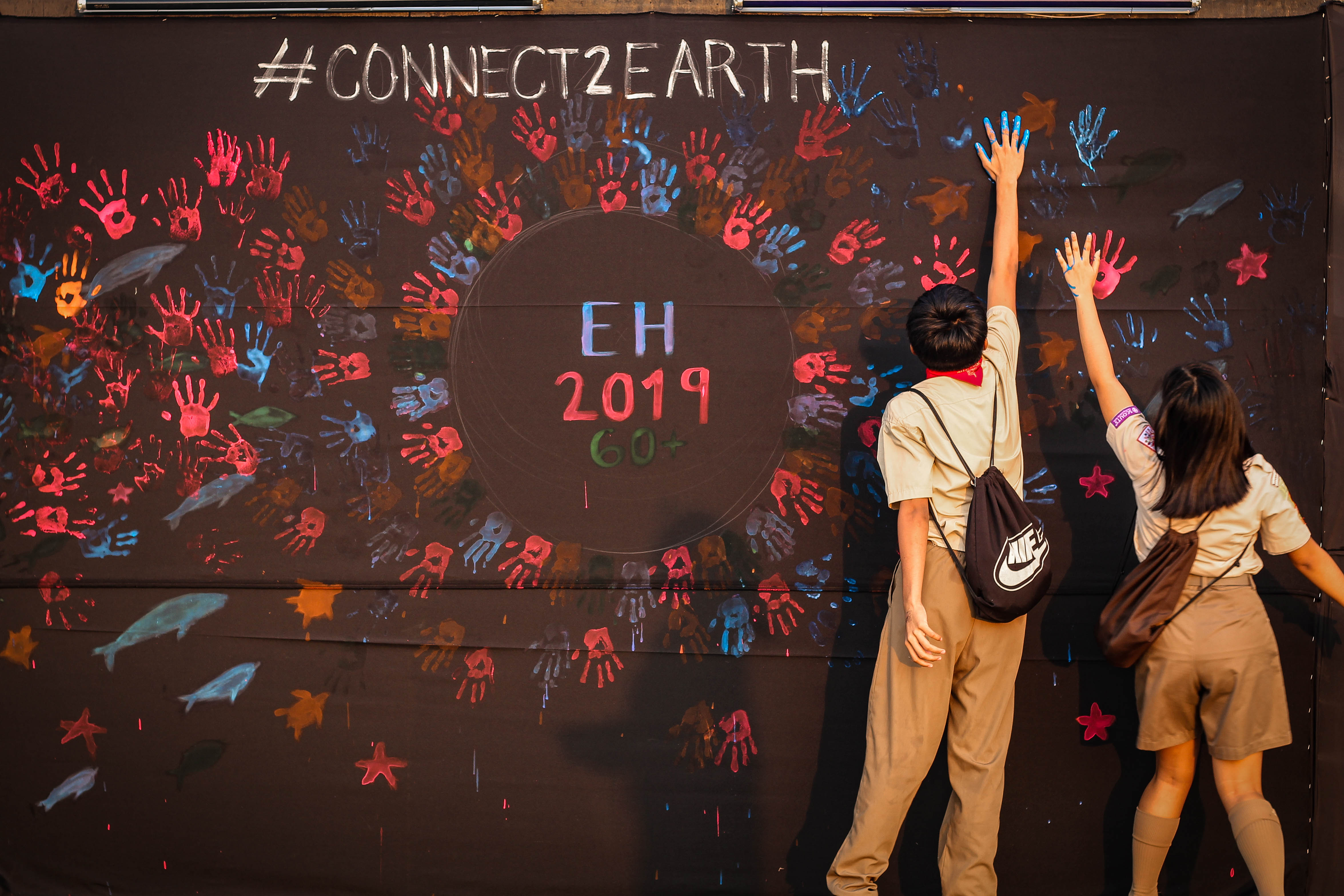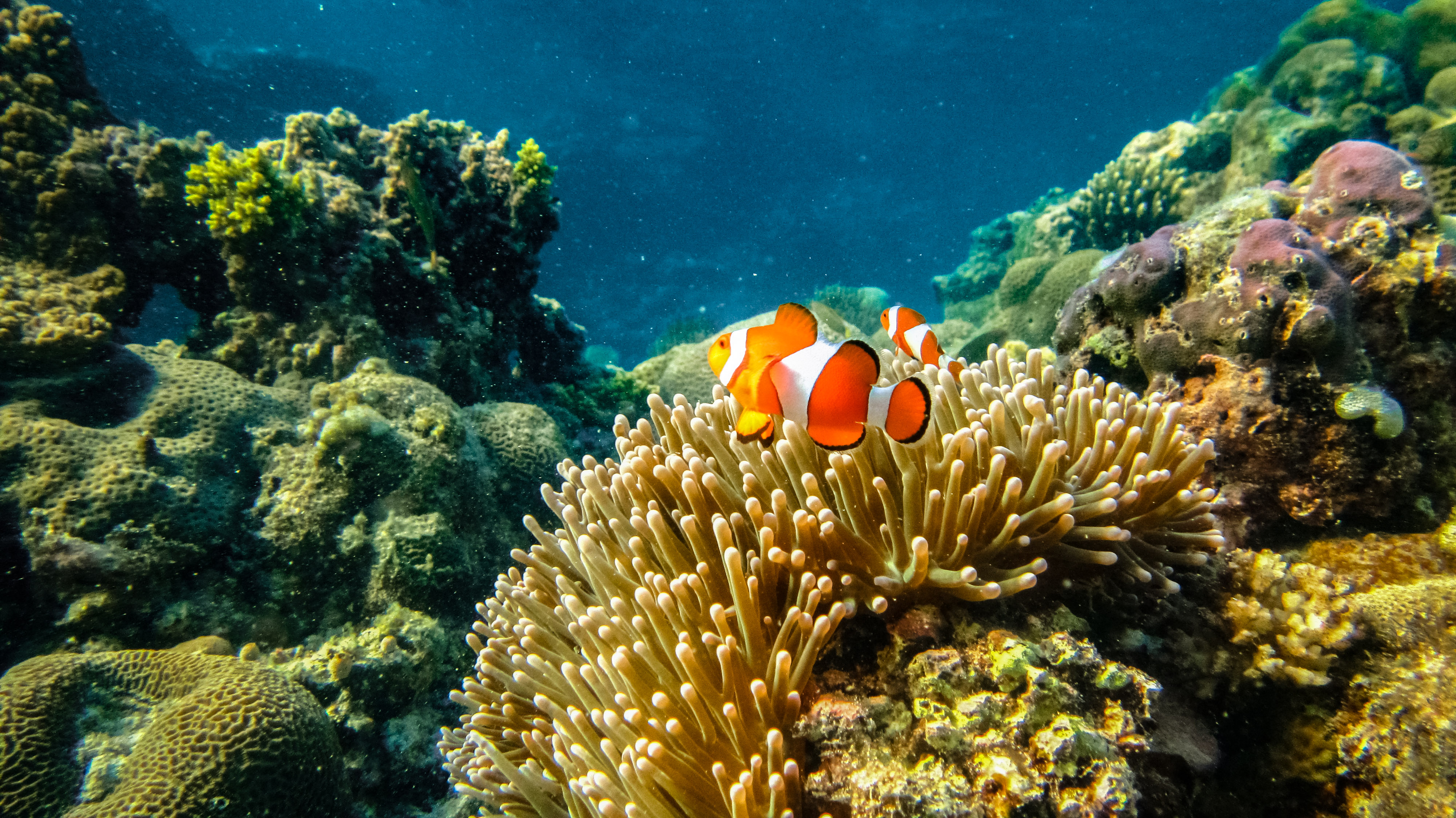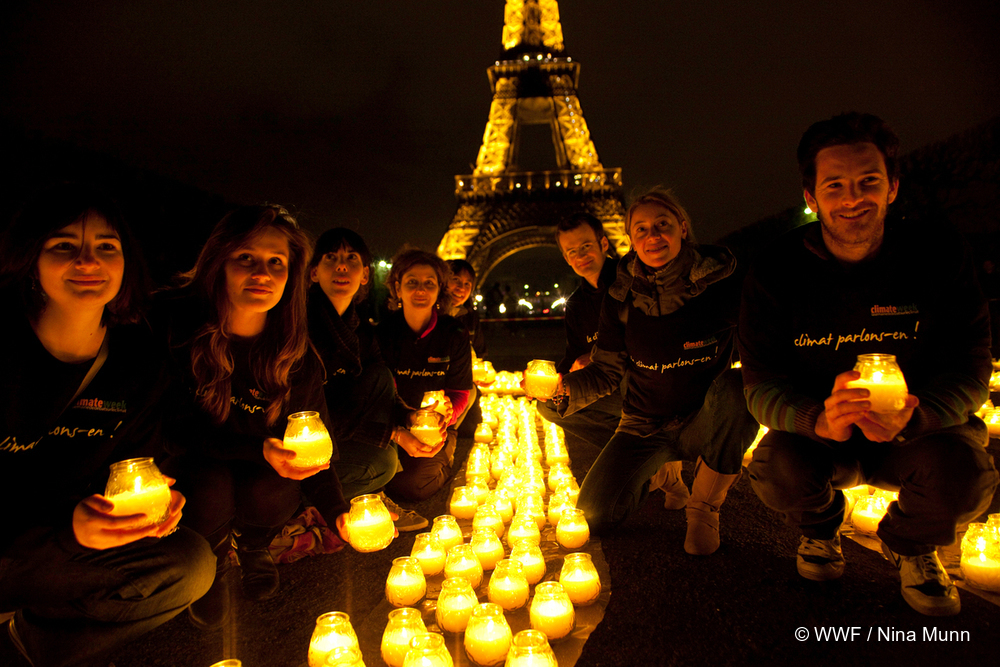Earth Hour 2019: For Our Shared Futures
March 2019

Young scouts add their hand prints to a pledge wall during Earth Hour Philippines 2019. Every year for over a decade, Earth Hour has brought people of all ages together in acts of symbolic commitment to the environment.
Photograph (c) Alo Lantin / WWF-Philippines
In the year 2020, our world leaders will be coming together for the 2020 UN Climate Change Conference. COP 26, they call it, and it is here that they will discuss the state of the world.
So what has become of our planet?
Just recently, a whale washed up on the shores of Compostela Valley with 40 kilograms of plastic in its stomach. Across the country, crops have failed and farmers have suffered with smaller and smaller yields and temperatures continue to rise, drying our dams and leaving our taps and water pipes running empty. Elsewhere, the Philippines has faced stronger and stronger storms, cutting their way across the country like never before.
A recent report from the Intergovernmental Panel on Climate Change (IPCC) stated that global temperatures were bound to increase by at least 1.5 degrees by the year 2050, with catastrophic implications for the planet. That same report said an increase of 2.0 degrees by 2050 may be seen as well. With it would come ice-free summers in the Arctic and a 170% increase in floods. Simultaneous problems of rising sea levels and severe drought will leave as many as 49 million people inundated and 410 million urban dwellers without a stable supply of water. Almost all coral reefs will be gone by the year 2100, with fishery resources expected to disappear as well. With failing crops and flaring temperatures, the IPCC does not predict a good future for the planet – and this is only with a two degree change in temperature. What about three? Four?
With alarm bells ringing on all sides, the threat of our degrading planet seems clear as day. In fact, they have been ringing for years already – and yet it seems we aren’t doing enough. What can we do in these desperate times?

WWF-Singapore stresses the threat of plastics during their Earth Hour 2018 celebrations. Over the years, Earth Hour has addressed the latest and most pressing of threats to the integrity of the environment. Photograph © WWF-Singapore
A People’s Movement
On the 31st of March, 2007 the people of Sydney, Australia switched off their lights at the same time. A total of over 2.2 million people flipped their switches in a sign of commitment to the conservation of our planet. That same month next year, cities all across the globe decided to join that commitment. Lights went off in the halls of great landmarks and the streets of city centers all over the world as Earth Hour grew into an international phenomenon. From the streets of Sydney that one day in 2007 it has grown to encompass over 7,000 cities in more than 180 countries across the globe.
As years go by the conversation evolves. Where before Earth Hour was a push against climate change, it has grown into a movement for biodiversity and for species conservation, an avenue to push for the security of our natural resources. In the Philippines, Earth Hour 2019 sheds a light on the threat of plastic pollution, a major threat to biodiversity and the latest environmental crisis to catch the attention of the public.
“With eight million tons of plastic entering our oceans every year, it’s impossible to ignore the problem. This year, we’re asking people to recognize and confront the threat of single-use plastics, so we can work toward a future where there are no plastics in nature,” said WWF-Philippines President and CEO Joel Palma.
A decade of commitments to the planet has turned Earth Hour into the world’s largest grassroots movement for the environment. Conversations grow and evolve in line with the latest, greatest threats to nature, and the movement has remained timely and progressive all throughout. But what happens beyond the hour? What has Earth Hour done for the planet?

A clownfish sits in its home anemone in a reef off the coast of Palawan. With nature hanging critically in the balance, movements like Earth Hour are needed to inspire a reconnection between man and nature. Photograph © Alo Lantin / WWF-Philippines
Beyond the Hour
Earth Hour has since grown to become a force far beyond those sixty minutes of darkness every March. In Kazakhstan, 17 million trees were planted in honor of the Hour; in French Polynesia, public protest under the banner of Earth Hour led to 5 million hectares of ocean being classified as a Managed Marine Area; in Peru, a no-plastic law was passed in the capital of Quito in honor of the movement - and so on, and so forth, and in cities and countries all across the planet.
With action comes protest and demand from a public concerned for their future. The year 2009 saw men and women take to the streets in a march on COP 15 - the first time the public took up the reigns in fighting for the planet. Crowds have gathered since then, lending their voices for the sake of environmental action. What happened a decade ago seems poised to happen again as clamour rises for increased climate action coming out of COP 26.
Early this year, an audience of over 30,000 children poured out into a public park in Sydney, almost twelve years since the first Earth Hour. Xander De Vries, a twenty year old and a youth himself, took to the stage and spoke. “It’s our time to rise up,” he said, speaking to the future generation. “We don’t have a lot of time left.”
De Vries may be right. We’re running out of time to save our shared home - and all over the world people have begun to realize that.

Citizens in France set candles down along a street in front of the Eiffel Tower as part of their own Earth Hour celebration. Across the world, people have been and continue to be moved to action in the spirit of Earth Hour. Photograph © Nina Munn / WWF
A Time to Act
The gravity of today’s most pressing environmental concerns weigh down on us heavier than ever before. The signs of dramatic change are all around, and it is tempting to sit in silence and ignore what is happening, or otherwise to stare at our news screens and despair at what is to come. We could stop and give up - or we could do something about what’s happening.
“We only have a little over a decade to keep things from spiraling out of control,” reminds WWF-Philippines Climate and Energy Head and Earth Hour Pilipinas National Director Atty. Gia Ibay, citing the findings of the latest IPCC report on the state of our world’s climate. According to said report, it isn’t only that a change of two degrees is possible. Rather, it appears to be the trajectory of our planet, considering current trends and status quo.
Despite the bad news that continues to pour in, people across the world continue to come together for the sake of planet earth. Campaigns continue to push for green and transformative policies while projects and individual actions continue to protect our damaged and critical natural resources. Our impact on the planet remains clear, but people remain optimistic.
“Change is needed and it is needed now, and we hope Earth Hour continues to be the force that brings us all together for the sake of the planet,” continues Ibay. With world leaders set to meet and with public pressure stronger than ever, we have found ourselves in a critical time in the protection of our planet. Earth Hour might just be that little push we need to bring the whole world together for the sake of our shared futures.
For more information, please contact:
Communications & Media Manager Mr. Dan Ramirez (dramirez@wwf.org.ph)
